Tutorial
Physical Layer
Data Link layer
Network Layer
Routing Algorithm
Transport Layer
Application Layer
Network Security
Misc
- Router
- OSI vs TCP/IP
- TCP vs UDP
- Transmission Control Protocol
- TCP port
- IPv4 vs IPv6
- ARP Packet Format
- ARP Table
- Working of ARP
- FTP Client
- FTP Commands
- FTP Server
- I2C Protocol
- Sliding Window Protocol
- SPI Protocol
- IP
- ARP Commands
- ARP
- Address Resolution Protocol
- ARP and its types
- TCP Retransmission
- CAN protocol
- HTTP Status Codes
- HTTP vs HTTPS
- RIP Protocol
- UDP Protocol
- ICMP Protocol
- MQTT protocol
- OSPF Protocol
- Stop and Wait Protocol
- IMAP Protocol
- POP Protocol
- CIFS
- DAS
- DIMM
- iSCSI
- NAS (Network Attached Storage)
- NFS
- NVMe
- SAN
- Border Gateway Protocol
- Go-Back-N ARQ
- RJ Cable
- Difference between Connection-Oriented and Connectionless Service
- CDMA vs. GSM
- What is MAC Address
- Modem vs. Router
- Switch Vs. Router
- USB 2.0 vs 3.0
- Difference between CSMA CA and CSMA CD
- Multiple access protocol- ALOHA, CSMA, CSMA/CA and CSMA/CD
- URI vs URL
- IMAP vs. POP3
- SSH Meaning| SSH Protocol
- UTP vs STP
- Status Code 400
- MIME Protocol
- IP address
- proxy server
- How to set up and use a proxy server
- network security
- WWW is based on which model
- Proxy Server List
- Fundamentals of Computer Networking
- IP Address Format and Table
- Bus topology and Ring topology
- Bus topology and Star topology
- Circuit Switching and Packet switching?
- Difference between star and ring topology
- Difference between Router and Bridge
- TCP Connection Termination
- Image Steganography
- Network Neutrality
- Onion Routing
- Adaptive security appliance (ASA) features
- Relabel-to-front Algorithm
- Types of Server Virtualization in Computer Network
- Access Lists (ACL)
- What is a proxy server and how does it work
- Digital Subscriber Line (DSL)
- Operating system based Virtualization
- Context based Access Control (CBAC)
- Cristian's Algorithm
- Service Set Identifier (SSID)
- Voice over Internet Protocol (VoIP)
- Challenge Response Authentication Mechanism (CRAM)
- Extended Access List
- Li-fi vs. Wi-fi
- Reflexive Access List
- Synchronous Optical Network (SONET)
- Wifi protected access (WPA)
- Wifi Protected Setup (WPS)
- Standard Access List
- Time Access List
- What is 3D Internet
- 4G Mobile Communication Technology
- Types of Wireless Transmission Media
- Best Computer Networking Courses
- Data Representation
- Network Criteria
- Classful vs Classless addressing
- Difference between BOOTP and RARP in Computer Networking
- What is AGP (Accelerated Graphics Port)
- Advantages and Disadvantages of Satellite Communication
- External IP Address
- Asynchronous Transfer Mode (ATM)
- Types of Authentication Protocols
- What is a CISCO Packet Tracer
- BOOTP work
- Subnetting in Computer Networks
- Mesh Topology Advantages and Disadvantages
- Ring Topology Advantages and Disadvantages
- Star Topology Advantages and Disadvantages
- Tree Topology Advantages and Disadvantages
- Zigbee Technology-The smart home protocol
- Network Layer in OSI Model
- Physical Layer in OSI Model
- Data Link Layer in OSI Model
- Internet explorer shortcut keys
- Network Layer Security | SSL Protocols
- Presentation Layer in OSI Model
- Session Layer in OSI Model
- SUBNET MASK
- Transport Layer Security | Secure Socket Layer (SSL) and SSL Architecture
- Functions, Advantages and Disadvantages of Network Layer
- Protocols in Noiseless and Noisy Channel
- Advantages and Disadvantages of Mesh Topology
- Cloud Networking - Managing and Optimizing Cloud-Based Networks
- Collision Domain and Broadcast Domain
- Count to Infinity Problem in Distance Vector Routing
- Difference Between Go-Back-N and Selective Repeat Protocol
- Difference between Stop and Wait, GoBackN, and Selective Repeat
- Network Function Virtualization (NFV): transforming Network Architecture with Virtualized Functions
- Network-Layer Security | IPSec Modes
- Next - Prev Network-Layer Security | IPSec Protocols and Services
- Ping vs Traceroute
- Software Defined Networking (SDN): Benefits and Challenges of Network Virtualization
- Software Defined Networking (SDN) vs. Network Function Virtualization (NFV)
- Virtual Circuits vs Datagram Networks
- BlueSmack Attack in Wireless Networks
- Bluesnarfing Attack in Wireless Networks
- Direct Sequence Spread Spectrum
- Warchalking in Wireless Networks
- WEP (Wired Equivalent Privacy)
- Wireless security encryption
- Wireless Security in an Enterprise
- Quantum Networking
- Network Automation
- Difference between MSS and MTU
- What is MTU
- Mesh Networks: A decentralized and Self-Organizing Approach to Networking
- What is Autonomous System
- What is MSS
- Cyber security & Software security
- Information security & Network security.
- Security Engineer & Security Architect
- Protection Methods for Network Security
- Trusted Systems in Network Security
- What are Authentication Tokens in Network security
- Cookies in Network Security
- Intruders in Network Security
- Network Security Toolkit (NST) in virtual box
- Pivoting-Moving Inside a Network
- Security Environment in Computer Networks
- Voice Biometric technique in Network Security
- Advantages and Disadvantages of Conventional Testing
- Difference between Kerberos and LDAP
- Cyber security and Information Security
- GraphQL Attacks and Security
- Application Layer in OSI Model
- Applications of Remote Sensing
- Seven Layers of IT Security
- What is Ad Hoc TCP
- What is Server Name Indication(SNI)
RIP Protocol
RIP stands for Routing Information Protocol. RIP is an intra-domain routing protocol used within an autonomous system. Here, intra-domain means routing the packets in a defined domain, for example, web browsing within an institutional area. To understand the RIP protocol, our main focus is to know the structure of the packet, how many fields it contains, and how these fields determine the routing table.
Before understanding the structure of the packet, we first look at the following points:
- RIP is based on the distance vector-based strategy, so we consider the entire structure as a graph where nodes are the routers, and the links are the networks.
- In a routing table, the first column is the destination, or we can say that it is a network address.
- The cost metric is the number of hops to reach the destination. The number of hops available in a network would be the cost. The hop count is the number of networks required to reach the destination.
- In RIP, infinity is defined as 16, which means that the RIP is useful for smaller networks or small autonomous systems. The maximum number of hops that RIP can contain is 15 hops, i.e., it should not have more than 15 hops as 16 is infinity.
- The next column contains the address of the router to which the packet is to be sent to reach the destination.
How is hop count determined?
When the router sends the packet to the network segment, then it is counted as a single hop.
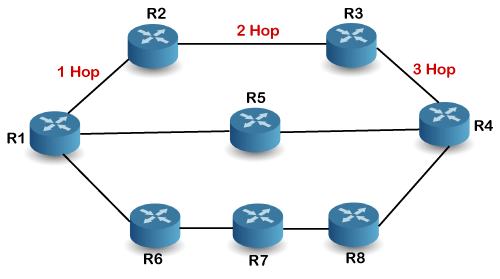
In the above figure, when the router 1 forwards the packet to the router 2 then it will count as 1 hop count. Similarly, when the router 2 forwards the packet to the router 3 then it will count as 2 hop count, and when the router 3 forwards the packet to router 4, it will count as 3 hop count. In the same way, RIP can support maximum upto 15 hops, which means that the 16 routers can be configured in a RIP.
RIP Message Format
Now, we look at the structure of the RIP message format. The message format is used to share information among different routers. The RIP contains the following fields in a message:
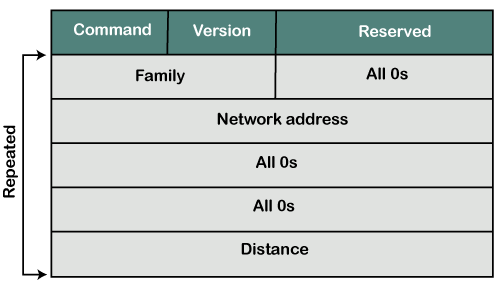
- Command: It is an 8-bit field that is used for request or reply. The value of the request is 1, and the value of the reply is 2.
- Version: Here, version means that which version of the protocol we are using. Suppose we are using the protocol of version1, then we put the 1 in this field.
- Reserved: This is a reserved field, so it is filled with zeroes.
- Family: It is a 16-bit field. As we are using the TCP/IP family, so we put 2 value in this field.
- Network Address: It is defined as 14 bytes field. If we use the IPv4 version, then we use 4 bytes, and the other 10 bytes are all zeroes.
- Distance: The distance field specifies the hop count, i.e., the number of hops used to reach the destination.
How does the RIP work?
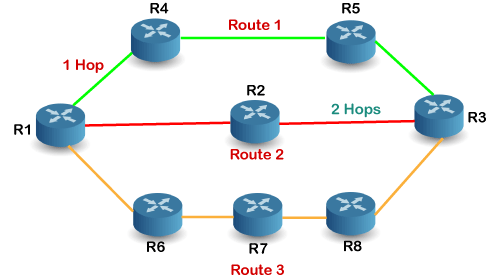
If there are 8 routers in a network where Router 1 wants to send the data to Router 3. If the network is configured with RIP, it will choose the route which has the least number of hops. There are three routes in the above network, i.e., Route 1, Route 2, and Route 3. The Route 2 contains the least number of hops, i.e., 2 where Route 1 contains 3 hops, and Route 3 contains 4 hops, so RIP will choose Route 2.
Let's look at another example.
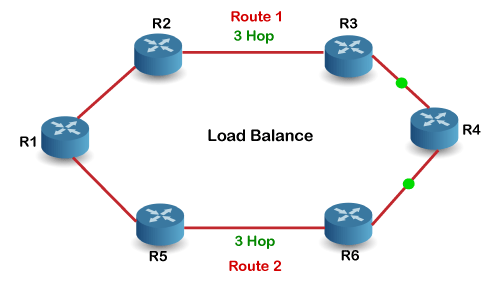
Suppose R1 wants to send the data to R4. There are two possible routes to send data from r1 to r2. As both the routes contain the same number of hops, i.e., 3, so RIP will send the data to both the routes simultaneously. This way, it manages the load balancing, and data reach the destination a bit faster.
Disadvantages of RIP
The following are the disadvantages of RIP:
- In RIP, the route is chosen based on the hop count metric. If another route of better bandwidth is available, then that route would not be chosen. Let's understand this scenario through an example.
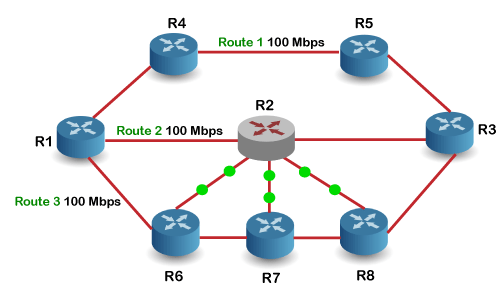
We can observe that Route 2 is chosen in the above figure as it has the least hop count. The Route 1 is free and data can be reached more faster; instead of this, data is sent to the Route 2 that makes the Route 2 slower due to the heavy traffic. This is one of the biggest disadvantages of RIP.
- The RIP is a classful routing protocol, so it does not support the VLSM (Variable Length Subnet Mask). The classful routing protocol is a protocol that does not include the subnet mask information in the routing updates.
- It broadcasts the routing updates to the entire network that creates a lot of traffic. In RIP, the routing table updates every 30 seconds. Whenever the updates occur, it sends the copy of the update to all the neighbors except the one that has caused the update. The sending of updates to all the neighbors creates a lot of traffic. This rule is known as a split-horizon rule.
- It faces a problem of Slow convergence. Whenever the router or link fails, then it often takes minutes to stabilize or take an alternative route; This problem is known as Slow convergence.
- RIP supports maximum 15 hops which means that the maximum 16 hops can be configured in a RIP
- The Administrative distance value is 120 (Ad value). If the Ad value is less, then the protocol is more reliable than the protocol with more Ad value.
- The RIP protocol has the highest Ad value, so it is not as reliable as the other routing protocols.
How RIP updates its Routing table
The following timers are used to update the routing table:
- RIP update timer : 30 sec
The routers configured with RIP send their updates to all the neighboring routers every 30 seconds.
- RIP Invalid timer : 180 sec
The RIP invalid timer is 180 seconds, which means that if the router is disconnected from the network or some link goes down, then the neighbor router will wait for 180 seconds to take the update. If it does not receive the update within 180 seconds, then it will mark the particular route as not reachable.
- RIP Flush timer : 240 sec
The RIP flush timer is 240 second which is almost equal to 4 min means that if the router does not receive the update within 240 seconds then the neighbor route will remove that particular route from the routing table which is a very slow process as 4 minutes is a long time to wait.
Advantages of RIP
The following are the advantages of a RIP protocol:
- It is easy to configure
- It has less complexity
- The CPU utilization is less.


